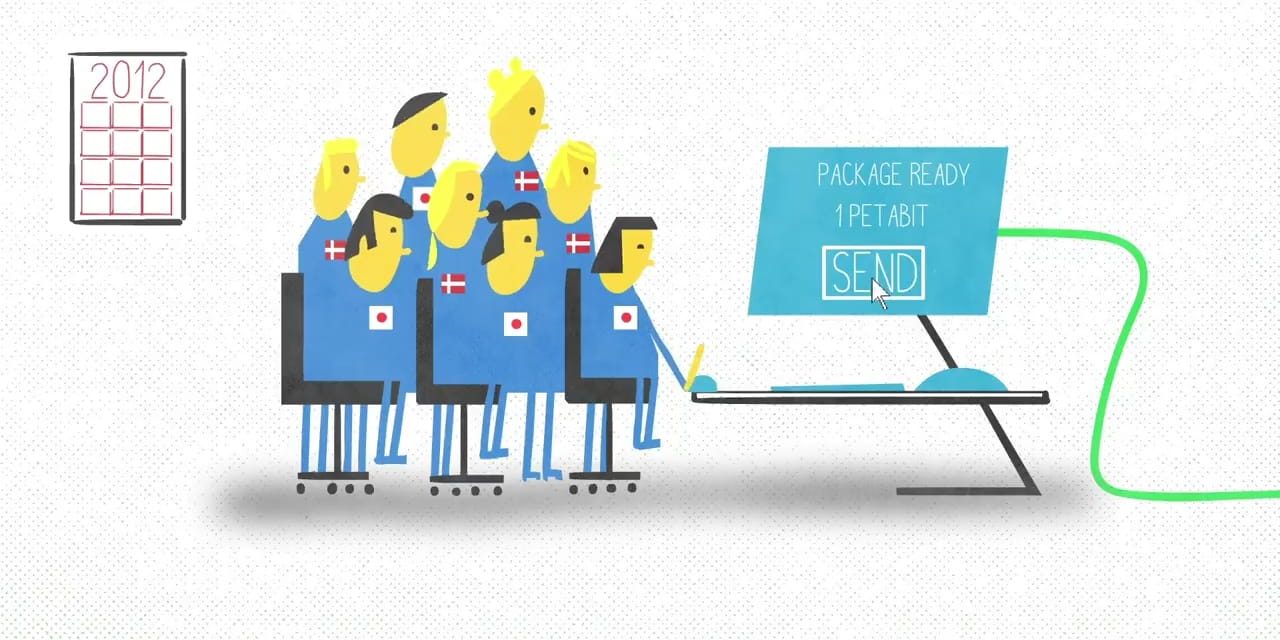In 2012, a team of Japanese and Danish researchers set a world record, transmitting 1 petabit of data that’s 10,000 hours of hight-def video, over a fifty-kilometer cable in a second. This wasn’t just any cable, it was a souped-up version of fiber optics, the hidden network that link our planet and make the internet possible. For decades, long-distance communications between cities and countries were carried by electrical signals, in wires made of cooper. This was slow and inefficient, with metal wires limiting data rates and power lost as wasted heat. But in the late 20th century, engineers mastered a far superior method of transmission. Instead of metal, glass can be carefully melted and drawn into flexible fiber strands, hundred of kilometers long and no thicker than human hair. And instead of electricity, these strand carry pulses of light, representing digital data. But how does light travel within glass, rather than just pass through it? The trick lies in a phenomenon known as total internal refelction. Since Isaac Newton’s time, lensmakers and scientists have kown that light bends when it passes between air and materials like water or glass. When a ray of light inside glass hits its surface at a steep angles, it refracts, or bends as it exits into air. But if the ray travels at a shallow angle, it’ll bend so far that it stays trapped, bounching along inside the glass. Under the right condition, something normally transparent to light can instead hide it from the world. Compared to electricity or radio, fiber optic signals barely degrade over great distances, a little power does scatter away and fibers can’t bend too sharply, otherwise the light leaks out. Today, a single optical fiber carries many wavelengths of light, each a different channel of data. And a fiber optic cable contains hundreds of these fiber strands. Over a million kilometers of cable crisscross our ocean floors to link the continents, that’s enough to wind around the equator nearly thirty time. With fiber optics, distance hardly limits data, which has allowed the internet to evolve into a planetary computer. Increasingly, our mobile work and play rely on legions of overworked computer serves, warehoused in gigantic data centers flug across the world. This is called cloud computing, and it leads to two big problems: heat waste and bandwidth demand. The vast majority of internet traffic shuttles around inside data centers, where thousends of serves are connected by traditional electrical cable. Half of their running power is wasted as heat. Meahwhile, wireless bandwidth demand steadily marches on, and the gigahertz signals used in our mobile device are reaching their data delivery limits. It seems fiber optics has been too good for its own good, fueling overly-ambitious cloud and mobile computing expectations. But a related technology, integrated photonics, has come to the rescue. Light can be guided not only in optical fibers, but also in ultrathin silicon wires. Silicon wires don’t guide light as well as fiber. But they do enable engineers to shrink all the device in a hundred kilometer fiber optic network down to tiny photonic chips that plug into servers and convert their electrical signals to optical and back. These electricity-to-light chips allow for wastefull electrical cables in data centers to be swapped out for power-efficient fiber. Photonic chips can help break open wireless bandwidth limitations, too. Researchers are working to replace mobile gigahertz signals with terahertz frequencies, to carry data thousends of times faster. But these are short-range signals: they get absorbed by moisture in the air, or blocked by tall buildings. With tiny wireless-to-fiber photonic transmitter chips distributed throughout cities, terahertz signals can be relayed over long-range distance. They can do so via a stable middleman, optical fiber, and make hyperfast wireless connectivity a reality. Now we’ve saddled light with information and redirected it to run along a fiber optic superhighway with many different integrated photonic exits to build an even more expansive, virtual world.
source : https://youtu.be/er3v4PVNQqE









Recent Comments